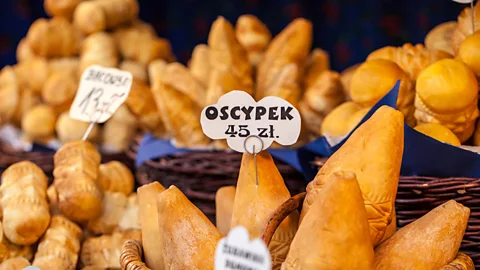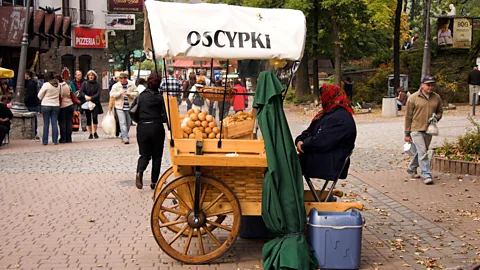Poland’s surprisingly beautiful cheese
 MARIUSZ PRUSACZYK/Alamy
MARIUSZ PRUSACZYK/AlamyOscypek, a golden-hued, spindle-shaped cheese, is as delicious as it is beautiful. But authentic versions are getting increasingly hard to find.
On Krupówki, Zakopane’s most famous street, you’ll find local products from all over Poland’s mountainous Podhale region. Tourists can buy jewellery (including brooches in the typical heart-shaped parzenica pattern), flowered skirts and an intricately carved cheese.
Sadly, the latter is likely to be fake. It is very hard to find authentic oscypek – as the decorative cheese is known – in Zakopane. Or anywhere else, really.
That’s because, as per EU regulations, this golden-hued, spindle-shaped cheese has very specific criteria. It must weigh between 600 and 800g and measure between 17 and 23cm. It also needs to be made from at least 60% sheep’s milk, and can only be produced between late April to early October when the sheep feed on fresh mountain grass. Before that, any milk they have is needed for the lambs. Any cheese that doesn’t fit the criteria must be sold as serki góralskie (Highland cheese).
Making 1kg of the cheese takes six to seven litres of milk. The fresh milk is heated, rennet is added and the mixture is stirred until lumps appear. The cheese is then shaped by hand and put into beautifully carved, wooden moulds called oscypiorka. The oscypki (plural of oscypek) are then smoked using pine or spruce wood, which gives them a rich golden colour on the outside and a creamy-white interior.
 Marek Uszynski/Alamy
Marek Uszynski/AlamyYou may also be interested in:
And oscypek is as delicious as it is beautiful. When Jamie Oliver tasted it in 2017, when cooking with Polish chef Damian Kordas, he said, “It almost feels like a firm mozzarella.” But while the texture is comparable, the taste is anything but. Oscypek is much sharper, brinier and smokier, due to its high sheep's milk content, as well as the process of first scalding then smoking the cheese.
It’s not just the cheesemaking process that’s still very traditional. Baca, (pronounced bah-tsa), a job which can be best described as a combination of head shepherd and cheese farmer, often still wear the typical clothing of the region: a woollen broadcloth coat, a shirt made of homespun flaxen cloth and a leather vest, along with moccasins and a black felt hat. Many of them have retained their distinct dialect.
“We make everything by hand,” said Janina Rzepka, one of the very few female bace (plural of baca) in Poland, who also runs a hotel in Bukowina Tatrzańska, a little village close to Zakopane where I learned to ski as a child. She explained that the buckets used for keeping and heating the milk are made of copper to prevent rusting, but everything else is made of wood.
 Pegaz/Alamy
Pegaz/AlamyThe cheese’s history can be traced back to the Vlachs, a tribe that arrived in Podhale from the Balkans around the 12th and 13th Centuries and brought the tradition of shepherding and cheesemaking to the region. The name oscypek comes from the word ‘scypać’, which means ‘to split’ in the local dialect. This is related to the moulds which are split into two parts. Other sources state that ‘scypać’ refers to pinching or kneading – another important part of the cheese-making process to make it more elastic and pliable.
Oscypki come in three sizes: small (which are oval), medium (shaped like a barrel), and big (shaped like a spindle, and the only size protected by the EU). You can also find the cheese in other shapes, such as hearts, rooster or deer. According to the Tatra Museum, the wooden moulds, and therefore the patterns on the cheese, were connected to the function the oscypek had to fulfil. Sometimes, they were used as currency – for example, to pay the shepherds. The cheeses were also given as gifts to the Church or the King’s court. The moulds themselves are still made by the shepherds from sycamore wood, as it is the only wood that doesn’t affect the cheese’s taste.
There are many ways to prepare oscypek. Traditionally, it’s eaten raw, grilled or fried, but it’s also delicious when added to salads or pasta dishes. It goes very well with lingonberry preserve – another Podhale delicacy. Rzepka suggested grating oscypek, mixing it with egg, putting it on a piece of bread, then frying it.
 Joanne Moyes/Alamy
Joanne Moyes/AlamyThe cheese has enjoyed an increase in popularity in recent years, mainly thanks to a growing interest in traditionally and locally produced food. Instead of parzenice or clothes, food-loving tourists now bring home oscypek, honey, lingonberry and cranberry preserves as well as local fruit syrups.
But while interest in eating the cheese has been increasing, the supply of authentic oscypek is declining. In 2008, when oscypek was granted Protected Designation of Origin from the European Union, sales immediately went up. But the requirement that it must be made from at least 60% sheep’s milk means that many bace find it hard to keep up with demand, since sheep’s natural milk-producing ability is much less than cows. This has led some traders to cut corners, using more cow’s milk than required or bathing the cheese in coffee (rather than smoking) to reproduce the dark, vibrant colour.
Many bace also struggle with bureaucracy, and the possibility of unexpected inspections.
“It’s annoying. We always have to write down how much cows’ milk and sheep’s milk we’re using. And if there are inspections, that’s an obstacle,” Rzepka said.
 Arletta Cwalina/Alamy
Arletta Cwalina/AlamyAnd, crucially, interest in making it is dwindling. A baca doesn’t have an easy life.
“The sheep are outside, and you have to sleep with them, and comfort them when they’re afraid at night. And they have to be milked twice a day,” Rzepka said, adding that in bacówki there is a lot of smoke. And since Zakopane is in the mountains, it can snow even in summer. That may be the reason why young people are not so keen on becoming bace, Rzepka said. Many prefer to go abroad instead.
Rzepka became a baca simply because her father was one. Traditionally, this profession has been ed from father to son, but for Rzepka, there was no-one else to take over the farm. “I did it because it just happened, and everyone knew me so that wasn’t a problem.”
 MARIUSZ PRUSACZYK/Alamy
MARIUSZ PRUSACZYK/AlamyTo help keep the profession alive, the Chamber of Crafts and Entrepreneurship in Katowice in the neighbouring Silesia region decided to take action. In 2013 they began organising examinations with the aim of protecting and regulating the industry. The practical part of the exam includes shearing and milking sheep, cutting their hooves and making cheese. The theoretical part covers the technology of cheese production, environmental protection, occupational health and safety, employee laws and running a business. Moreover, all applicants are required to have the necessary work experience.
So far, 23 people have achieved the title ‘juhas’(the person who helps the baca), 95 people are ‘apprentice baca’, and six people have reached the top rank of ‘master baca’.
Visitors to the Podhale region are welcome to browse Krupówki Street. But for authentic, EU-certified oscypek, it’s best to visit a baca directly. Rzepka suggests visiting different bacówki (little huts where the cheese is made) and trying various cheeses as every baca makes oscypek according to his or her own preferences. In addition, the quality and type of grass the sheep eat also play a role, making each piece of cheese unique.
“Either they’ll fall in love with the taste or they won’t,” she said.
more than three million BBC Travel fans by liking us on Facebook, or follow us on Twitter and Instagram.
If you liked this story, sign up for the weekly bbc.com features newsletter called "If You Only Read 6 Things This Week". A handpicked selection of stories from BBC Future, Earth, Culture, Capital and Travel, delivered to your inbox every Friday.
